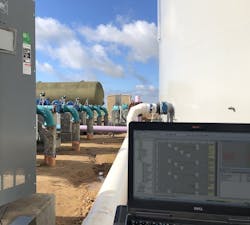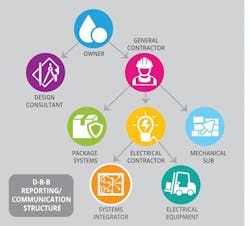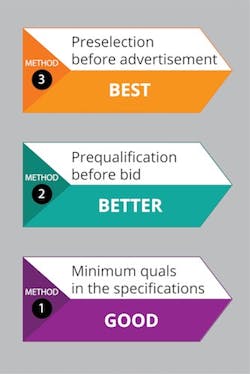About the author:
Richard Haugh, P.E., is director of project management for Tesco Controls, Inc. Haugh can be reached at [email protected].
Utilities planning a major treatment plant or collection or distribution system project have too much at stake to risk their investment on a failed process control system. Unfortunately, public works low-bid procurement methods can result in an unqualified control system integrator (SI) being selected, often accompanied by difficulties integrating the SI into the project team. The consequences can include a failed project, dissatisfied owner and a control system requiring expensive modifications after the project is complete.
While there are several alternative delivery methods starting to gain popularity in the water and wastewater industry, the conventional design-bid-build process is still the most common.
Control system integration activities on these projects are critical because the water or wastewater plant, facility, collection or distribution system cannot function until the control system is installed and successfully commissioned. The right SI can improve upon project execution when he or she is involved early enough in the project and is regarded as a trusted partner.
Picking the Right Partner
On many public works treatment facility projects, there often is no upfront qualification process for the SI, leaving selection entirely up to the electrical or general contractor. Often, this selection is made solely on price. Problems can be expected throughout the project if the SI lacks the required knowledge, experience and expertise to properly complete the work.
To secure a qualified SI, the owner must begin by engaging a designer who understands and appreciates the significance of the control system to a project’s success. This designer can work in conjunction with the owner to establish stringent qualifications for SI selection, ensuring only suitable firms are considered.
There are three common methods for ensuring a qualified SI is selected on a project, listed in order of effectiveness.
Method 1: The first method is to include minimum qualifications for the SI in the technical specifications. If properly written and enforced, this method will encourage electrical contractor bidders to team up with a more qualified SI, and it will reduce the inclination to select the SI based solely on price.
Minimum SI qualifications include:
- Company size (the project should not represent more than 20% of a firm’s business);
- Experience on similar water or wastewater projects;
- Certification through the Control Systems Integrator Assn.;
- Experience with the software and other main products planned for use on the project;
- Possession of applicable manufacturers’ certifications; and
- A fully-staffed office within reasonable distance from the project site to facilitate the project most effectively.
The weakness of this method is that it can lead to arguments after the prime contract is awarded with respect to whether the proposed SI meets the minimum qualifications. The low bidder usually has included pricing from a specific SI in their bid, so changing the SI after awarding the bid usually means paying a higher price. Changes at this point often
are contentious.
Method 2: Conducting a prequalification before the bid opening avoids arguments after contract award. Each prospective SI is required to submit qualifications prior to project bidding. The owner and design engineer review these submissions and disqualify SI firms not meeting minimum qualifications. Bidders are required to select from among the qualified SI firms. This provides reasonable control over the selection process and avoids disputes after bid opening or the contract being awarded.
Method 3: Preselection provides the greatest degree of control. With this alternative, prospective SI firms are evaluated prior to contract advertisement. This is accomplished with a separate advertisement requesting qualification statements, and possibly pricing, by interested firms. As a result of this process, one or more pre-selected SI firms are named in the specifications. Even sole-sourced selection prior to bid can be justified if a particular SI has a long and successful history with the owner.
Common Issues on Design-Bid-Build Projects
Regardless of the selection process, there are steps the owner can take to maximize SI effectiveness. To understand these recommendations, the most common challenges an SI faces on a typical large project include:
- The misperception that control systems integration is not essential to project success;
- Underdeveloped control system design;
- The SI is a third-tier contractor or supplier and is removed from project management, project information and project decisions;
- Lack of adequate and accurate information, particularly existing conditions and standards; and
- Operations staff are the ultimate customers of the control system, yet they are typically not well represented on the project until near the end.
On a large, multi million-dollar facility design and construction project, the control system is a small cost item on the project. The design engineer, construction manager and general contractor generally are not focused on control system issues, nor are they experts in the technology. Consequently, they often downplay the importance of the role of the SI to overall project success.
Another common issue arises when the entity creating bid documents, usually a consulting engineer, has a low level of control system expertise. Design firms often are selected primarily based on their process expertise. While this proficiency is critical for water and wastewater projects, a solid understanding of control systems is also needed for project success.
These two factors often combine to cause poor development of the control system plans and specifications, requiring the SI to complete the design during the construction project. A qualified SI will work cooperatively with the design engineer and the owner to finalize the technical details as well as the look and feel of the new system. By restricting the selection to a qualified SI, this can be accomplished with minimal disruption to overall project execution.
During execution of the work, there must be a high level of coordination and cooperation among the owner, the designer, the general contractor, the SI and other entities, even if the design incorporates good control system principles. Systems integration is an information-intensive discipline. The SI must be able to readily access information on existing conditions, control packages provided by other vendors on the project and operations staff needs and preferences. All of this requires effective communications among the SI and other project stakeholders.
Coordination, Cooperation & Communications
Once the right SI is selected, the owner should advocate early and often for a high-quality design and implementation process. The owner should insist on workshops throughout the control system development lifecycle with participation by all the key project stakeholders. The owner and the designer must work with the selected SI to establish control system configuration, programming and other standards, and to ensure these standards are met.
Establishing an effective relationship between the owner and the SI early, and then maintaining it throughout the project, is crucial to success. This will facilitate information flow to the SI so it can work efficiently and effectively.
The owner should be able to communicate directly with the SI to exchange information, get questions answered, request no-cost changes and learn about the developing control system. This type of communication can be promoted by establishing lines of communication early in the project, and by holding frequent project meetings and workshops.
A common difficulty for these projects is lack of early participation by operations staff to select the control system’s look and feel. Operators are the users of the control system and have their needs and preferences. When they are not included in human machine interface screen development, for instance, there can be a lot of dissatisfaction during startup, requiring rework. The remedy is to include operations staff in the development workshops and submittal reviews, and to provide them with adequate time to review screen submittals.
Whenever control system issues arise, the owner should insist upon the inclusion of the SI in all related communications. In many cases, the SI can suggest improved technical designs, but this requires the owner to trust the SI and to be open to technological and procedural alternatives.
Conclusion
Control system design and execution on water and wastewater projects are critical to success. To ensure a well-qualified SI is chosen, pre-qualification requirements should be added to control SI selection, and the owner may wish to consider alternative procurement methods.
The SI is responsible for procuring, configuring and coordinating various components and services on a project to produce a complete and integrated control system. More than most other project participants, the SI needs information on owner standards, preferences and existing facilities to perform its work effectively and efficiently. The owner’s staff should advocate early in the project to elevate the importance of control system issues and the role of the SI throughout the project lifecycle.


